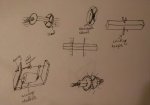gm280
Supreme Mariner
- Joined
- Jun 26, 2011
- Messages
- 14,590
I see progress and it looks interesting. I see you are using a fly tying spool setup to feed out the magnet wire and keep it straight. Good idea. You may want to check out some guitar pickup builds and see how they keep track and wind pickups. It seem like very similar work. Keep posting. :thumb:






















